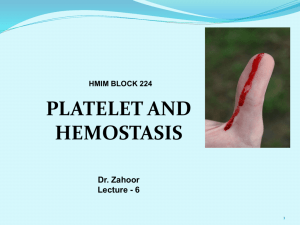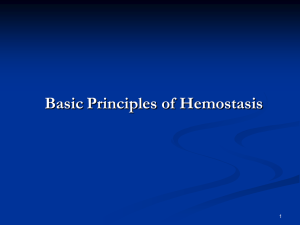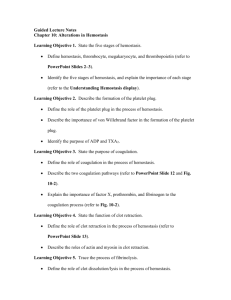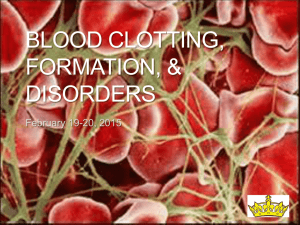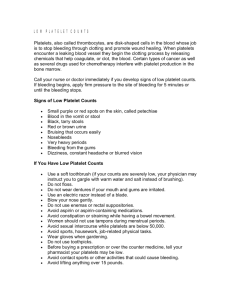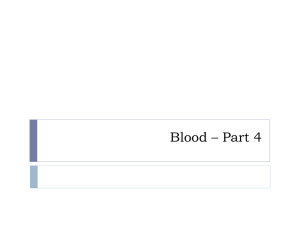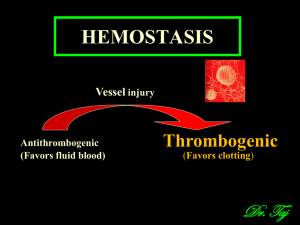L 6 Hemostasis
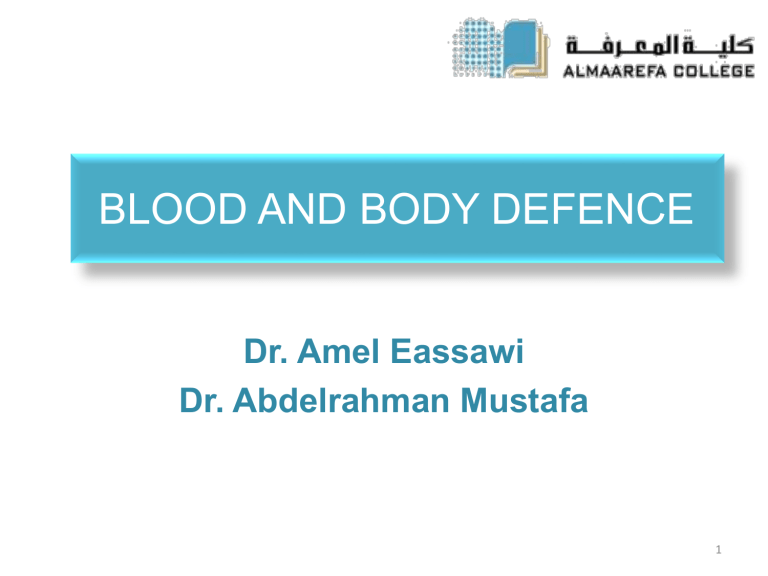
BLOOD AND BODY DEFENCE
Dr. Amel Eassawi
Dr. Abdelrahman Mustafa
1
HMIM 224
L 6: HEMOSTASIS
2
OBJECTIVES
The student should be able to:
Define hemostasis and explain the mechanisms that help to achieve it.
Review the major steps in coagulation.
Explain how to prevent coagulation.
3
PLATELETS
•
Formed in bone marrow, 150-400,000 /µl
• The hormone thrombopoietin, produced by the liver stimulate the bone marrow for production of thrombocytes.
• 2-4 µm in diameter, life span 8-12 days, no nucleus
Active Cytoplasm:
Actin + myosin
Enzyme synthesis + storage of calcium
Synthesis of prostaglandins
Dense granules containing ADP, serotonin and ATP
Alpha granules (fibrinogen, PDGF (Platelet-derived Growth
Factor), VWF (Von Willbrand Factor), fibronectin)
Fibrin stabilizing factor
4
PLATELETS
Membrane:
Receptors: Thrombin, ADP, serotonin.
Adhesion proteins: VWF, fibronectin, collagen, fibrinogen.
Coat of glycoproteins: Adhesion to injured areas.
Phospholipids: Activation of intrinsic pathway
Adenylate cyclase, cAMP: Activate other platelets
5
HEMOSTASIS
•
Hemostasis refers to the stoppage of bleeding
• Stages of hemostasis:
• Blood vessel spasm
• Platelet plug formation
• Blood coagulation
6
HEMOSTASIS
1. Blood Vessel Spasm:
• Triggered by pain receptors, platelet release, or serotonin.
• Smooth muscle in blood vessel contracts.
2. Platelet plug formation
• Triggered by exposure of platelets to collagen
• Platelets adhere to rough surface to form a plug
7
HEMOSTASIS
Stages of Platelet Plug Formation:
1. Platelet adhesion
• Von Willebrand factor (VWF)
2. Platelet activation
• Ca ++ releaase
• Granule discharge
• Integrin on surface
• Thromboxane formation (TX
A2
)
3. Platelet aggregation
8
HEMOSTASIS
9
HEMOSTASIS
3.Blood Coagulation:
• Triggered by cellular damage and blood contact with foreign surfaces
• A hemostatic mechanism causes the formation of a blot clot via a series of reactions which activates the next in a cascade.
• Occurs extrinsically (tissue factor pathway) or intrinsically (contact activation pathway).
10
CLOTTING FACTORS
11
CLOTTING CASCADE
• Series of steps involving 12 plasma clotting factors that lead to final conversion of fibrinogen into a stabilized fibrin mesh.
• May be triggered by
Intrinsic pathway
• Involves seven separate steps
• Factor XII (Hageman factor) is activated by coming into contact with exposed collagen in injured vessel or foreign surface such as glass test tube.
12
Intrinsic Pathway
Figure 36-4;
Guyton & Hall
13
CLOTTING CASCADE
Extrinsic pathway
• Requires only 4 steps
• Requires contact with tissue factors external to the blood.
• Tissue thromboplastin released from traumatized tissue directly activates factor X.
14
Extrinsic Pathway
Figure 36-3;
Guyton & Hall
15
Clot Pathways
16
17
FATE OF BLOOD CLOTS
• After a blood clot forms it retracts and pulls the edges of a broken blood vessel together while squeezing the fluid from the clot.
• Platelet-derived growth factor stimulates smooth muscle cells and fibroblasts to repair damaged blood vessel walls.
• Plasmin digests the blood clots.
• Plasmin is a plasma protein produced by the liver, present in the plasma as inactive form plasminogen .
• Plasmin is activated in a cascade of reaction involve many factors.
18
PREVENTION OF COAGULATION
• The smooth lining of blood vessels discourages the accumulation of platelets and clotting factors.
• As a clot forms fibrin absorbs thrombin and prevents the clotting reaction from spreading
• Anti-thrombin inactivates additional thrombin by binding to it and blocking its action on fibrinogen.
• Some cells such as basophils and mast cells secrete heparin (an anticoagulant).
19
20
ABNORMAL BLOOD CLOTTING
• Thrombus
– Abnormal intravasculaar clot attached to a vessel wall
• Emboli
– Freely floating clots
• Factors that can cause thromboembolism
– Roughened vessel surfaces associated with atherosclerosis
– Imbalances in the clotting-anti-clotting systems
– Slow-moving blood
– Occasionally triggered by release of tissue thromboplastin into blood from large amounts of traumatized tissue.
• Hemophilia
– Excessive bleeding caused by deficiency of one of the factors in the clotting cascade.
21
COAGULATION DEFECTS
I. Vitamin C Deficiency
- Lack of stable collagen (elderly, alcoholics)
2. Hepatic Failure
- Almost all clotting factors are made in the liver
3. Vitamin K Deficiency
- Required for factor II (prothrombin), VII, IX, and X
4. Hemophilia
22
HEMOPHILIA
• Hemophilia A is classic hemophilia (a disease referring to the inability to clot blood). About 80% is Hemophilia A.
• It is due to deficiency in factor VIII.
• Symptoms include:
– Joint and muscle hemorrhage
– Easy bruising
– Prolonged bleeding from wounds.
• Treatment of hemophilia A is accomplished by infusion of factor VIII concentrates prepared from either human plasma or by recombinant DNA technology.
• Hemophilia B results from deficiencies in IX.
• Hemophilia C results from deficiencies in XI.
23
COAGULATION DEFECTS
• ITP (Idiopathic thrombocytopenic purpura (ITP) is the condition of having an abnormally low platelet count (thrombocytopenia) of unknown cause (idiopathic). autoimmune (common).
• Characterize by bleeding of small capillaries in the skin.
24
ANTIHEMOSTATIC DRUGS
Heparin:
• Activate antithrombin III.
• Antithrombin III inactivates various coagulation factors including thrombin.
• Used in prevention of Deep vein thrombosis (DVT) &
Pulmonary embolism (PE).
• During heart surgery and hemodialysis.
25
ANTIHEMOSTATIC DRUGS
Aspirin:
- An important inhibitor of platelet activation.
- By inhibiting the activity of cyclooxygenase (COX) prostaglandin-endoperoxide synthase (PTGS) ,
- Cyclooxygenase responsible for formation of prostaglandins , prostacyclin and thromboxane .
26
ANTIHEMOSTATIC DRUGS
• The drug clopidogrel: Plavix is an irreversible inhibitor of the ADP receptor on platelet membranes., thus Plavix interferes with the process of platelet aggregation.
• Tissue plasminogen activator (tPA) is highly selective for the degradation of fibrin in a clot. Used particular during the short period following myocardial infarct.
• Streptokinase (an enzyme from the Streptococci bacterium) is another plasminogen activator.
27
TESTS
1. PLATELET DISORDER:
Bleeding Time : The time it takes for the bleeding to stop.
• Normally 2-6 min.
• Increased bleeding time in thrombocytopenia
2. COAGULATION DISORDERS:
1. Clotting Time: The time required for a sample of blood to coagulate in vitro under standard conditions.
• Normally 5-11 min.
• Increased clotting time in hemophilia
2. Partial Thromboplastin Time (PTT)
• For intrinsic & common pathway
• Normally less than 45 sec.
3. Prothrombin Time (PT)
• For extrinsic & common pathway.
• Usually around 12–13 seconds
28
SUMMARY
29
REFERENCES
Human Physiology, Lauralee Sherwood, seventh edition.
Text book Physiology by Guyton &Hall,11 th edition.
Text book of Physiology by Linda S. Contanzo, third edition.
Physiology by Berne and Levy, sixth edition.
30




